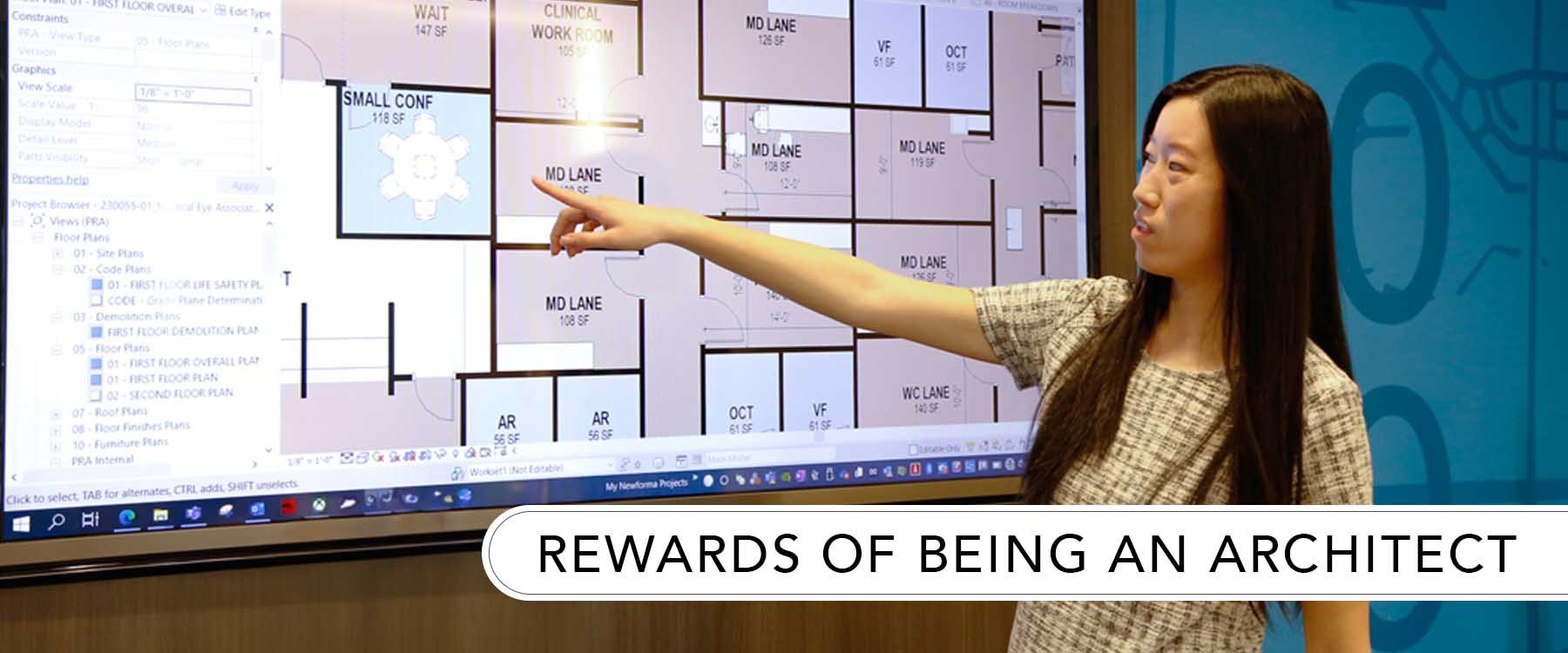A message to aspiring architects
This day, the day following Thanksgiving 2023, has been spent counting my blessings. One blessing that has impacted every corner of my life, is the blessing of being an architect.
I love being an architect. We get to help clients every day, and we work at the convergence of creativity, technology, and innovation. The work can be invigorating, and I sometimes continue to ponder the day’s challenges on my drive home or in the morning shower, and reading research over lunch or in the evening. I love the intellectual challenge! This is a profession in which one truly practices lifelong learning.
People often ask how I chose architecture, what is it like to be an architect, or how to become an architect. So I thought I would ramble on a bit about the benefits of being an architect for those students and young adults who may be thinking about a career in architecture.
I think that being an architect is more than a profession; it is a vocation that melds science and art. As architects, we are entrusted with shaping the physical environment that surrounds us all. Architecture seamlessly blends creativity, technical acumen, and an understanding of the inner workings of client operations. The ability to transform abstract concepts into tangible, aesthetically pleasing yet functional structures is a worthy challenge and a true privilege.
Beyond the design, modeling, and drafting tasks, architecture involves a deep sense of responsibility. Architects are not designing to please our own ego; we are problem solvers who help clients articulate the needs of their organizations and bring solutions to life. It is about understanding the intricate balance between the artistic expression of a structure and the practical needs of its inhabitants, of how to use architecture and design to solve client challenges.
Benefits of Being an Architect:
- Architecture allows your creativity to be unleashed: Architects provide the creativity behind structures that define our cities, and the articulate details that hold our buildings together. Architecture provides an unparalleled outlet for creative expression, allowing architects to turn imagination into tangible form. The thrill of conceptualizing a design, from the initial sketches to the final built form, is a real joy.
- Architects may make impactful contributions: Architects play a pivotal role in shaping communities and influencing the way people interact with their surroundings. The impact of a well-designed building extends far beyond its physical structure and can leave a lasting impression on a community. Contributing to the built environment provides architects with a sense of purpose and accomplishment.
- Architecture provides diverse career paths: The field of architecture offers many career paths, from residential design to healthcare design, from individual buildings to urban planning, and from highrise design to interior architecture, ensuring that architects can pursue areas of personal interest. Whether designing sustainable structures, historic preservation, or futuristic urban landscapes, or specializing in vertical markets like healthcare architecture, education architecture, or the creation of senior living environments, the career possibilities are endless.
- Architects engage in continuous learning: Architecture is a field that evolves with technological advancements and societal changes. Both change continuously. This constant evolution ensures that architects become lifelong learners, always adapting to new materials, technologies, and design trends. Staying aware of these developments not only keeps architects professionally relevant but also fuels a sense of intellectual curiosity and personal growth.
- Architecture is a collaborative endeavor: Architects constantly work closely with professionals from various disciplines in a rich interdisciplinary respectful work environment. This collaborative spirit enhances problem-solving skills and encourages innovative thinking. The collaboration occurs around functional and aesthetic design issues or around the technical construction issues that need to be addressed for success. Working with clients, engineers, interior designers, and construction teams creates a dynamic and stimulating atmosphere, where diverse perspectives contribute to project success through collaborative problem-solving.
The Responsibility of Helping Clients:
Beyond the creative and technical aspects, architects are responsible for helping clients translate their desires into tangible structures. This involves soft skills such as effective communication, active listening, and a deep understanding of the client’s needs and aspirations of their organization. Architects act as translators between the abstract client discussion and the practical constraints of the built world. This responsibility, to apply design skills to resolve client challenges, is often forgotten when discussing architecture. I think it is odd that our responsibility to the client is overlooked, or diminished, in these discussions because it lies at the core of what we do.
Helping clients understand how their needs result in certain spaces requires empathy and the ability to distill complex ideas into tangible designs. It is really not about creating buildings, per se, but is about creating fulfilling experiences with the people who inhabit them. Designing for people is at the core of what we do. Sometimes it is hard for clients to visualize what we imagine. The satisfaction that comes from a client’s pleasure of the finished building is one of the most satisfying benefits of being an architect.
In many ways, being an architect is not just a profession but a calling—a calling in service of both the aesthetic and functional needs of the world. It is about understanding that the spaces we design influence the way people live, work, and interact. The responsibility is immense, but so is the potential to create a positive impact and legacy of good.
Pros and Cons of Architecture:
Like all professions, Architecture is rewarding but also has some negative attributes. Let’s explore the pros and cons of being an architect through a simple table:
| Pros of Being an Architect | Cons of Being an Architect |
|---|---|
| Creativity and Contribution to Design | Challenging Schedules |
| Impactful Contributions | Lengthy Education and Training |
| Diverse Career Paths | Project Uncertainties |
| Continuous Learning | Intense Competition |
| Collaborative Endeavors | Balancing Art and Budget |
| Satisfaction in Helping Clients Resolve Challenges | The Stress of Meeting Client Expectations |
| Opportunities for Innovation and Technological Growth | Challenges in Balancing Work-Life |
| Influence on the Built Environment and Community | Financial Uncertainty in the Early Career Stages |
I could go on in detail about the positive aspects of architecture. And I have intentionally skipped over the negative aspects as there are many corners of the internet with that information. I believe that the benefits of being an architect outweigh the stereotyped negative aspects you’ll find on any list of the pros and cons of being an architect. Architecture is a rewarding career marked by the joy of creation, the satisfaction of contributing to communities, and the constant pursuit of excellence. While challenges exist, the benefits of this profession make it an exciting and fulfilling endeavor for those truly excited about shaping the built environment.
So, future architects, embrace the possibilities that lie ahead, recognizing that being an architect is not just a career but a profound calling to shape your world. Allow your creativity to soar and follow your sense of responsibility to guide you on this remarkable journey!
About the Author:

Mike is a partner of PRA and directs the activities of marketing and business development for the firm. He believes being an architect includes many responsibilities including putting client needs ahead of his own. Mike is experienced in research, the predesign process, and planning design solutions in response to business needs. Feel free to contact Mike to discuss your business needs or opportunities for partnering.
